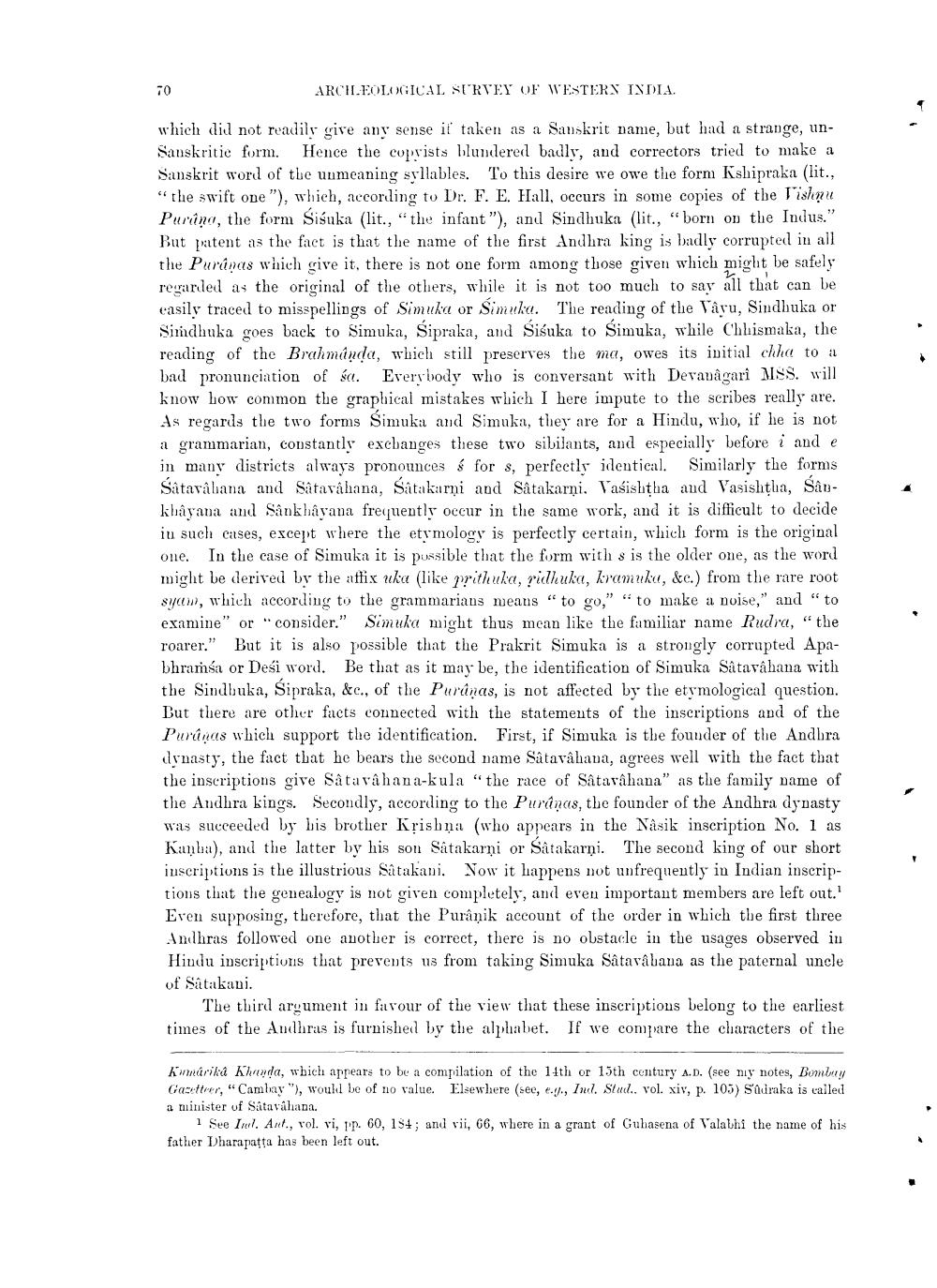________________
70
ARCHEOLOGICAL SURVEY OF WESTERN INDIA.
which did not readily give any sense if taken as a Sanskrit name, but had a strange, unSanskritie form. Hence the copyists blundered badly, and correctors tried to make a Sanskrit word of the unmeaning syllables. To this desire we owe the form Kshipraka (lit., "the swift one "), which, according to Dr. F. E. Hall, occurs in some copies of the Vishnu Purang, the form Sisuka (lit., "the infant "), and Sindhuka (lit., "born on the Indus." But patent as the fact is that the name of the first Andhra king is badly corrupted in all the Puranas which give it, there is not one form among those given which might be safely regarded as the original of the others, while it is not too much to say all that can be easily traced to misspellings of Simuka or Simeke. The reading of the Vayu, Sindhuka or Sindhuka goes back to Simuka, Sipraka, and Sisuka to Simuka, while Chhiamaka, the reading of the Brahmanda, which still preserves the ma, owes its initial chha to a bad pronunciation of sa. Everybody who is conversant with Devanagari MSS. will know how common the graphical mistakes which I here impute to the scribes really are. As regards the two forms Simuka and Simuka, they are for a Hindu, who, if he is not a grammarian, constantly exchanges these two sibilants, and especially before i and e in many districts always pronounces & for 8, perfectly identical. Similarly the forms Satavaliana and Sitaváhana, Satakarni and Sitakarni. Vasishtha and Vasishtha, Sâukhayana and Sankhayana frequently occur in the same work, and it is difficult to decide in such cases, except where the etymology is perfectly certain, which form is the original one. In the case of Simuka it is possible that the form with s is the older one, as the word might be derived by the affix uka (like prithuka, ridhuka, kramuka, &c.) from the rare root syam, which according to the grammarians means "to go," "to make a noise," and "to examine" or "consider." Simuka might thus mean like the familiar name Rudra, "the roarer." But it is also possible that the Prakrit Simuka is a strongly corrupted Apabhramsa or Desi word. Be that as it may be, the identification of Simuka Sâtavâhana with the Sindhuka, Śipraka, &c., of the Puriyas, is not affected by the etymological question. But there are other facts connected with the statements of the inscriptions and of the Puranas which support the identification. First, if Simuka is the founder of the Andhra dynasty, the fact that he bears the second name Sâtavâhana, agrees well with the fact that the inscriptions give Satavahana-kula "the race of Sâtavâhana" as the family name of the Andhra kings. Secondly, according to the Paris, the founder of the Andhra dynasty was succeeded by his brother Krishna (who appears in the Nasik inscription No. 1 as Kanba), and the latter by his son Satakarni or Satakarni. The second king of our short inscriptions is the illustrious Sitakani. Now it happens not unfrequently in Indian inscriptions that the genealogy is not given completely, and even important members are left out.' Even supposing, therefore, that the Puranik account of the order in which the first three Andhras followed one another is correct, there is no obstacle in the usages observed in Hindu inscriptions that prevents us from taking Simuka Sâtavâbana as the paternal uncle of Sâtakani.
The third argument in favour of the view that these inscriptions belong to the earliest times of the Andhras is furnished by the alphabet. If we compare the characters of the
Komárika Khanda, which appears to be a compilation of the 14th or 15th century A.D. (see my notes, Bombay Gazetteer, "Cambay "), would be of no value. Elsewhere (see, e.g., Ind. Stud.. vol. xiv, p. 105) Sûdraka is called a minister of Satavahana.
1 See Ind. Ant., vol. vi, pp. 60, 154; and vii, 66, where in a grant of Guhasena of Valabhi the name of his father Dharapatta has been left out.




